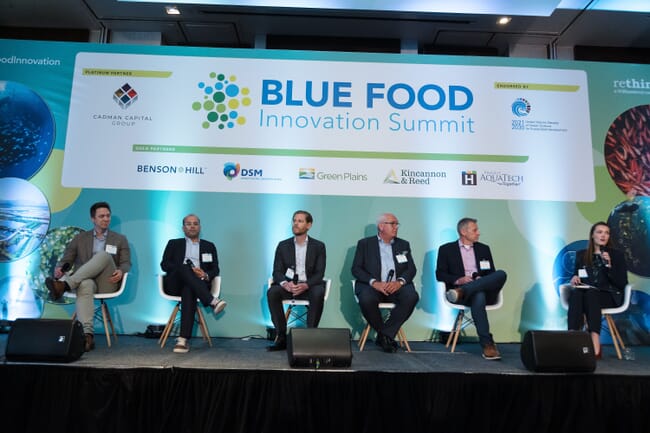
Øyvind Fylling-Jensen, CEO of Nofima, is third from the right
Speaking at last week’s Blue Food Innovation Summit in London, Øyvind Fylling-Jensen, CEO of Nofima, outlined the organisation’s research into novel feed ingredients, stressing the importance of using as wide a range of ingredients as possible in aquafeed. However, he also warned that there is still a lot of work to be done.
Indeed, Nofima has been anlaysing the potential of a wide range of novel ingredients – ranging from plant-based proteins to fish offcuts – and the CEO emphasised the importance of respecting the nutritional requirements of farmed animals.
“From an investor point of view it’s important to recognise that you can’t fool biology with money or technology. You have to put the biology of the fish and the fish welfare in first place. If you try to jump that part you will run into challenges sooner rather than later. You have to look at the nutritional value, the trace elements, the vitamins – all that kind of stuff,” he noted.
Fylling-Jensen also noted that many novel ingredients would struggle to replace key bulk ingredients – such as fishmeal, fish oil and soy protein concentrate.
“When you look at the alternative feedstuffs – be it plant-based, bacterial proteins, yeast cell proteins – it’s the scalability and the affordability that you have to look at. Are you able to source them in a sustainable way without damaging nature and are you able to put it into an industrial scale that allows you to prosper? I think a lot of the new initiatives will not be replacements of current feed ingredients, but will be add-ons or supplements to widen the basket of raw materials that goes into the feed. Be it algae oil with enhanced EPA and DHA, or plants like rapeseed, you have to look at whether it’s available, is it affordable, is it accessible and does it cause the fish to grow,” he added.
Fylling-Jensen also added that, while salmon was one of the main species that were being targeted for alternative feed ingredients, the potential to introduce alternative ingredients into feed for other species groups was – in the long term – likely to be much more exciting.
“You must remember that salmon is just a very, very small species in aquaculture and marine aquaculture is a very small part. You have to look at the vast opportunities in all other species – that’s where the possible future for investors is,” he explained.
Fylling-Jensen also warned of the difficulties of incorporating novel ingredients into aquafeeds, in terms of the physical impacts that they can have on feed pellet structure.
“You have to formulate [these novel ingredients] into a pellet that’s able to survive transport, bagging, packaging, blowing through the pipes at a sea site. So you have to understand the physical properties of a pellet as you make it. It’s not only ‘here you have a protein source’ you put into the pellet, what works in the lab does not necessarily work at the [farm] site or a large pond, where it’s fairly rough handling. Being able to develop feed from the raw material the whole way through - from small scale to large operational scale - is a very important part,” he noted.


